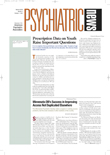A baby with colic is one of a new mother’s toughest challenges. Yet there may be some good news for those new mothers who have one: The excessive, inconsolable, maddening crying will probably be over by three months of age, and the mothers will probably survive the experience without psychological damage.
So, at least, suggests a study conducted by Tammy Clifford, Ph.D., director of epidemiology at the CHEO Research Institute in Ottawa, Ontario, Canada; Fabian Gorodzinsky, M.D., an assistant professor of pediatrics at the University of Western Ontario; and coworkers. The study was published in the December Archives of Pediatrics and Adolescent Medicine.
Colic is a relatively common condition of early infancy, characterized by crying, fussiness, and irritability at least three hours a day and occurring more than three days in any one week, even though an infant is healthy and well fed. Although studies have suggested that colic usually ends by three months of age, with little lasting effect on either infant or mother, these studies have focused on clinically referred cases and have been retrospective in nature. So Clifford and her colleagues decided to undertake a prospective study based on a general population sample to see whether they would get the same finding.
They recruited some 550 women who gave birth in London, Ontario, in 1999 to participate in their study. Subjects were given four questionnaires to fill out. The first questionnaire, given one week after mother and newborn were discharged from the hospital, used standardized instruments to identify and measure maternal anxiety and depression. The second and third questionnaires, given at six weeks and at three months after hospital discharge, consisted of standardized instruments designed to identify and measure infants’ crying behaviors. The fourth questionnaire, given at six months after hospital discharge, used standardized instruments to identify and measure maternal anxiety and depression.
Clifford and her coworkers first used the data to determine how prevalent infant colic was at six weeks after discharge and again at three months after discharge. They learned that whereas 131 infants had had colic at six weeks, only 18 still had it at three months, indicating that 86 percent of cases had remitted by three months. This finding was essentially what researchers have found in retrospective studies, further bolstering the case that most cases of colic will cease around three months of age.
Clifford and her colleagues then used the data to determine whether their subjects’ mental states had been influenced by having a colicky baby. They found that mothers who had not had a colicky infant experienced, on average, less anxiety and depression at six months after hospital discharge than they had experienced one week after discharge. They also found that mothers who had had a colicky infant experienced, on average, less anxiety and depression at six months after hospital discharge than they had experienced one week after discharge, but the reduction was not as great as for the former group. However, the difference in anxiety and depression reduction between the two groups was not statistically significant.
So, having a colicky baby at six weeks after discharge may make mothers a little more anxious and depressed than they would have been if they had had a noncolicky baby at six weeks after discharge, but not all that much more so, Clifford and her team concluded.
This study, however, did not specifically address the mental health of those 18 mothers who had the misfortune of having a colicky baby not just six weeks after discharge, but still at three months after discharge. It is quite possible that the mental health of these women suffered a lot more than that of the women exposed to colic for a shorter period.
Nor did the investigation address the mental health of the 17 mothers whose infants did not become colicky until three months after discharge. In an accompanying editorial, Ronald Barr, M.D., a McGill University colic authority, proposed that it may very well be those infants who become colicky only at three months, and not earlier, who have difficult temperaments.
An abstract of the study, “Sequelae of Infant Colic: Evidence of Transient Infant Distress and Absence of Lasting Effects on Maternal Mental Health,” is posted on the Web at http://archpedi.ama-assn.org. ▪
Arch Pediatr Adolesc Med 2002 156 1183
